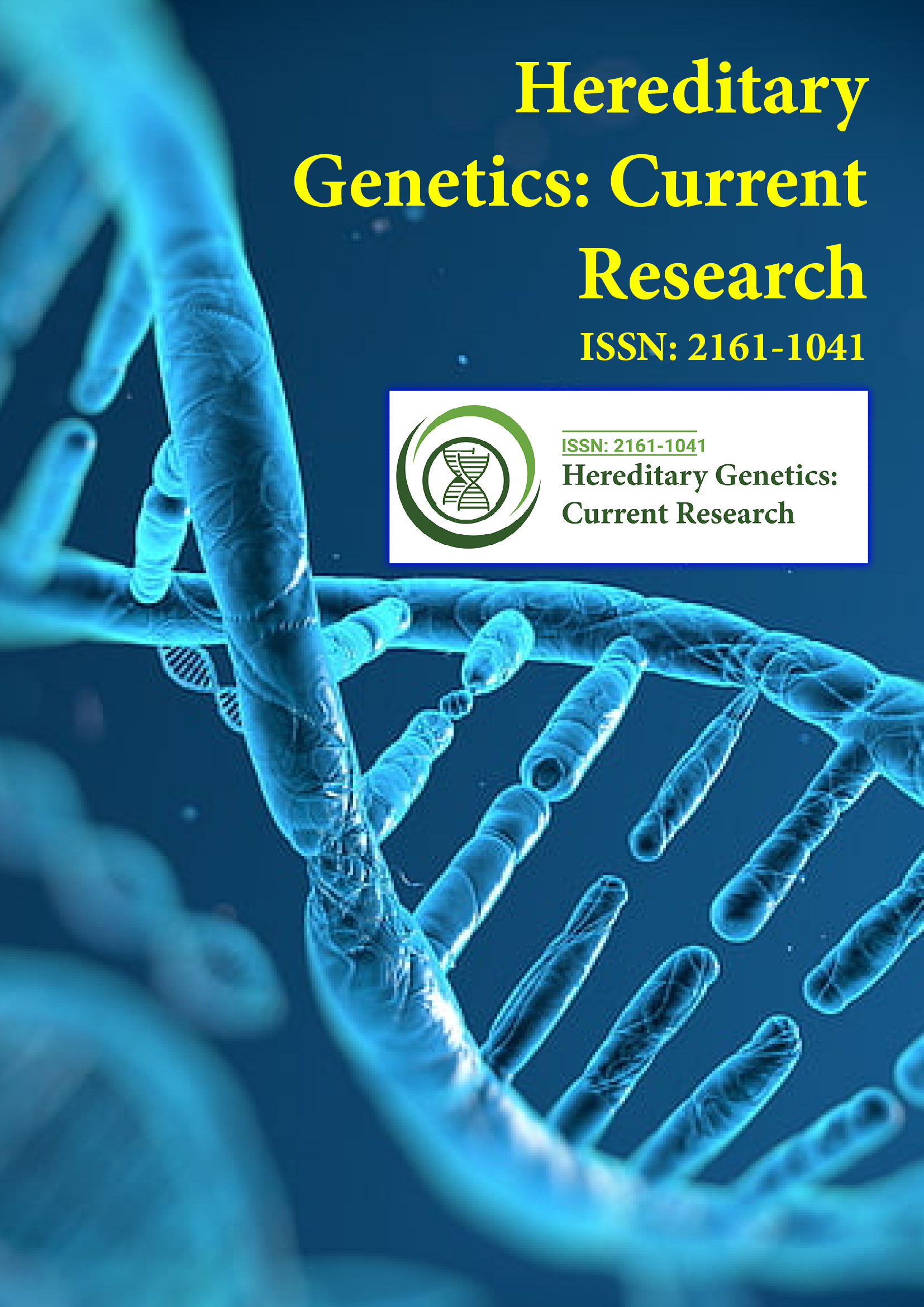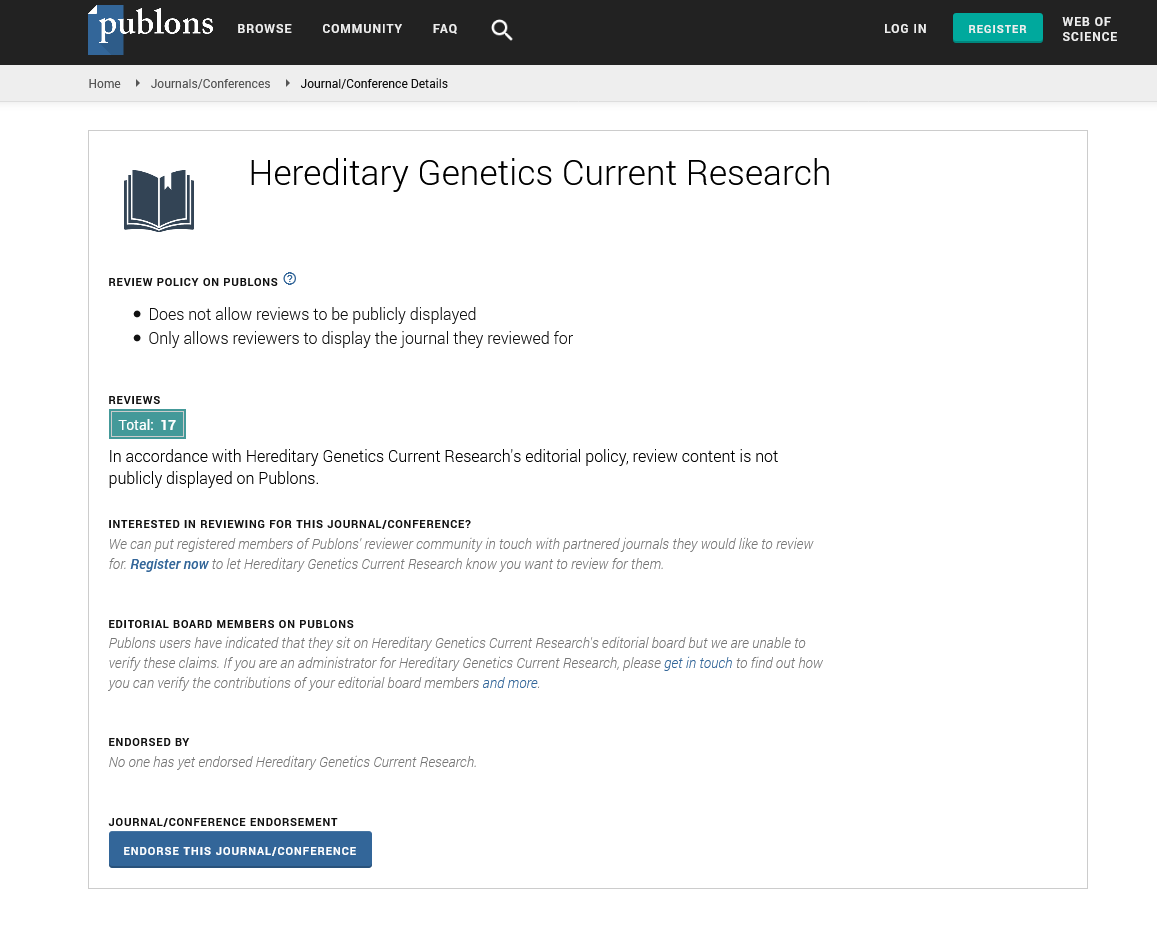Indexed In
- Open J Gate
- Genamics JournalSeek
- CiteFactor
- RefSeek
- Hamdard University
- EBSCO A-Z
- NSD - Norwegian Centre for Research Data
- OCLC- WorldCat
- Publons
- Geneva Foundation for Medical Education and Research
- Euro Pub
- Google Scholar
Useful Links
Share This Page
Journal Flyer

Open Access Journals
- Agri and Aquaculture
- Biochemistry
- Bioinformatics & Systems Biology
- Business & Management
- Chemistry
- Clinical Sciences
- Engineering
- Food & Nutrition
- General Science
- Genetics & Molecular Biology
- Immunology & Microbiology
- Medical Sciences
- Neuroscience & Psychology
- Nursing & Health Care
- Pharmaceutical Sciences
Opinion Article - (2023) Volume 12, Issue 1
Clinical Characteristics and Molecular Genetics of Myotonic Dystrophy Type 1 (DM1)
Michael Ledley*Received: 03-Mar-2023, Manuscript No. HGCR-23-20840 ; Editor assigned: 06-Mar-2023, Pre QC No. HGCR-23-20840 (PQ); Reviewed: 20-Mar-2023, QC No. HGCR-23-20840 ; Revised: 27-Mar-2023, Manuscript No. HGCR-23-20840 (R); Published: 03-Apr-2023, DOI: 10.35248/2161-1041.23.12.240
Description
The most common kind of adult-onset muscular dystrophy is Myotonic Dystrophy Type 1 (DM1, MIM 160900). Its clinical manifestation is uncommon, with substantial diversity between and within pedigrees and a striking genetic anticipation, with the age at onset typically decreasing by 25 to 35 years per generation. DM1 is passed down in an autosomal dominant manner. The downstream SIX homeobox 5 gene (SIX5, MIM* 600963) promoter has an unstable increase in Cytosine–Thymine– Guanine (CTG) repeats that is the cause of the underlying mutation. DM1 is classified as a "disorder of unstable repeat expansion" according to the nature of the causative mutation.
DM1 is one of the most varied hereditary human illnesses, with symptoms ranging from asymptomatic adults to seriously afflicted neonates with congenital onset. The primary clinical variants of diabetes mellitus type 1 include late-onset/mild, adult-onset/ classical, childhood-onset/juvenile, and congenital. The adultonset variant is the most frequent, with onset often occurring in the second or third decade of life and clinical presentation typical of DM1. Muscular signs include gradual muscular degeneration that results in weakening and wasting of face, neck, and distal limb muscles, which eventually extends more proximally.
Myotonia, defined clinically as a gradual relaxation of a normal muscle contraction, often affects the distal limbs as well as the cranial and axial muscles. Cataract, cardiac conduction abnormalities and arrhythmias, endocrine dysfunctions, gastrointestinal and respiratory involvement, frontal baldness, axonal peripheral neuropathy, neurobehavioral symptoms, and cognitive impairment are the most prevalent systemic consequences. The congenital variant is the most severe, frequently manifesting in pregnancy as polyhydramnios and decreased foetal movement. The major symptoms after delivery are severe widespread muscular weakness, hypotonia, and respiratory impairment. This extreme muscle weakness is caused by developmental abnormalities rather than degenerative changes, as in the adult-onset variety. The most common cause of death in congenital form is respiratory problems within the first first year of life, with long-term ventilation having a dismal prognosis. Children that survive without a difficult neonatal history have developmental delays. When hypotonia improves, they overcome motor delays, and they begin to walk; nonetheless, their intellectual development is poor, and the vast majority of them remain mentally retarded. Clinical myotonia and muscular degeneration typically manifest in late infancy.
Myotonia is common throughout puberty, and distal muscle weakness may develop. Individuals with the childhood-onset form exhibit many of the symptoms seen in the adult-onset variant in their second decade of life. Cataracts and baldness are two possible symptoms. Myotonia, which is only detectable by electromyography, may occur late in life. Dynamic mutations are unstable changes in the copy number of simple DNA repeats. They are linked to at least 22 genetic neurological diseases known as "disorders of unstable repeat expansion," which include Huntington's disease, fragile X syndrome, spinal and bulbar muscular atrophy, and others. In normal humans, simple DNA repeats vary in copy number and are stably transmitted with an average mutation rate of 103 per locus per gamete every generation. Expansions begin in loci undergoing dynamic mutations when the length of simple DNA repeats exceeds a threshold of 100-150 bases. After this threshold is crossed, additional expansions become increasingly likely, resulting in the accumulation of hundreds to thousands of repeats in just a few generations. The progressive nature of the expansion process across generations, combined with the typical genotypephenotype association, gives a biological basis for the longdebated phenomena of genetic anticipation, which is seen in the majority of "disorders of unstable repeat expansion."
The number of CTG repeats in the DMPK gene is variable in the general population, ranging from 5 to 35, and increases dramatically in DM1 people, ranging from 50 to several thousand. The magnitude of the unstable CTG repeats is inversely associated to both the age of onset and the overall severity of the disease. Asymptomatic or late-onset DM1 patients typically had 50 to 80 CTG repeats, and these relatively modest expansions are referred to as protomutations. In late-onset DM1 patients, the maximum amount of the expansion is 150 CTG repeats. Adult-onset DM1 patients have CTG repeat numbers ranging from 100 to 1000 (mean size 650 repeats), whereas congenital and childhood-onset DM1 patients have more than 1000 repeats (mean size 1200 repeats). Disease-associated mutations are defined as expansions of more than 80 CTG repeats. DMPK alleles that fall between the normal and protomutation range (35 to 50 repetitions) are extremely rare.
They are frequently unrelated to the disease and are referred to as premutations. Until recently, the CTG array in the DMPK gene was thought to be a pure tract, unlike the majority of other simple DNA repeats associated with "disorders of unstable repeat expansion." However, 4% of DM1 patients showed several CCG triplets, CCGCTG hexamers, or CTC triplets positioned at the 3′ end of the CTG array. Variant repeats do not appear to exist in normal DM1 alleles.
Citation: Ledley M (2023) Clinical Characteristics and Molecular Genetics of Myotonic Dystrophy Type 1 (DM1). Hereditary Genet. 12.240.
Copyright: © 2023 Ledley M. This is an open-access article distributed under the terms of the Creative Commons Attribution License, which permits unrestricted use, distribution, and reproduction in any medium, provided the original author and source are credited.

